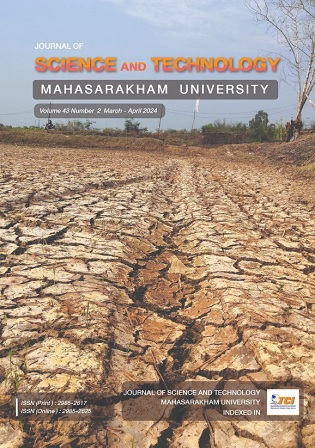Characteristics of a needle free drug delivery by using impact driven method
Main Article Content
Abstract
At present, animal drug delivery using an injection device is a process involving a pressing force from a syringe directed through a syringe needle into the subcutaneous layer. However, there are disadvantages for drug action efficiency and time consuming injection. Therefore, this research aims to study the feasibility of application of the animal injection device using a new concept involving a high speed liquid jet with impact driven method. It delivered a high speed liquid jet penetrating through the skin without the use of a needle. The volume of liquid in the nozzle was 2 ml in experiments to compare the characteristics using the driving object method (distance 0 mm) and impact driven method (impact distances are 5, 7, 9, 11, 13, 15 and 17 mm). The characteristics such as, impact force of power source, average jet velocity, impact pressure of the jet, jet power and the behavior of jet were examined using a high-speed video camera. The results showed that, the impact distance increased, the impact force value of the power source increased, which an impact distance of 17 mm gave a maximum impact force of 475 N. The average velocity and the impact pressure of the jet are compared. An impact distance of 11 mm gave the maximum value of the average velocity and the impact pressure of jet to be 62 m/s and 2.28 MPa, respectively. Subsequently, the values of the impact distance were reduced to 13, 15 and 17 mm. The impact jet pressure value of the driving object method (distance 0 mm), and the level of impact jet pressure values was lower than the standard value such that it could not penetrate through the skin. Impact distances of 5, 7, 9, 11,13, 15 and 17 mm provided a high enough impact jet pressure to penetrate the skin.
Article Details
References
วิระพันธ์ สีหานาม. (2557). การฉีดยาแบบไร้เข็มด้วยลำพุ่งความเร็วสูง: อุปกรณ์และพฤติกรรมการฉีด. วารสารวิชาการ วิศวกรรมศาสตร์ ม.อบ. ปีที่ 7(ฉบับที่ 2), 113-124.
Akihito, K., Nanami, E., Sennosuke, K., Chihiro, K., Kumido, O., Akane, T, & Yoshiyuki, T. (2019). Visualization of penetration of a high-speed focused microjet into gel and animal skin. J Vis. 22, 449-457.
Baxtera, J. S., Katrencikb, J and Mitragotria, S. (2004). Jet injection into polyacrylamide gels: investigation of jet injection mechanics, Journal of Biomechanics. 37, 1181-1188.
Baxtera, J. S., and Mitragotria, S. (2004). Needle-free jet injection: dependence of jet penetration and dispersion in the skin on jet power, Journal of Controlled Release. 97, 527-535.
Mukda, P., Seehanam, W. and Pianthong, K. (2017). A new concept of needle-free jet injector by the impact driven method, ASME Journal of Medical Devices. 11(1) 1-10.
Shi, H. H. (1994). Study of Hypersonic Liquid Jet, Doctor of thesis Sendai, Japan: Tohoku University.
Shi, H. H. and Takayama, K. (1995). Generation of high speed liquid jets by high speed impact of a projectile, JSME International Journal. 3(8) 181-190.
Shi, H. H., Takayama, K. and Itoh, M. (1996). Further study of the generation technique of high speed liquid jets and related shock wave phenomena using a helium gas gun, Japanese Journal of Applied Physics. 35, 4147-4156.
Seehanam, W., Kianthong, K. and Sittiwong, W., Milton, B.E. and Takayama, K. (2012). Investigation on the generation process of impact-driven high-speed liquid jets using a CFD technique, Shock Waves. 22, 465–475.


